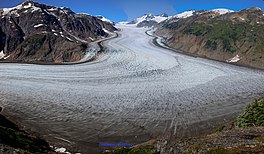|
Salmon Glacier
The Salmon Glacier is a glacier located ~25 km (16 mi) north of Stewart, British Columbia, and Hyder, Alaska, just on the Canadian side of the border. The glacier, one of hundreds in the Boundary Ranges, is notable for its major potential as a natural hazard. Summit Lake is located at the northern end of the glacier and every year around mid-July the lake breaks an ice-dam and then flows under the Salmon Glacier into the Salmon River. This causes the river to rise approximately 4–5 ft (1.2–1.5 m) for several days.[citation needed] The glacier can be accessed by road from Hyder, Alaska, from early July to late September. The glacier's name was officially adopted January 20, 1955, by the Geographical Names Board of Canada.[1] ClimateBased on the Köppen climate classification, Salmon Glacier is located in the marine west coast climate zone of western North America.[2] Most weather fronts originate in the Pacific Ocean, and travel east toward the Coast Mountains where they are forced upward by the range (Orographic lift), causing them to drop their moisture in the form of rain or snowfall. As a result, the Coast Mountains experience high precipitation, especially during the winter months in the form of snowfall. Temperatures can drop below −20 °C (−4 °F) with wind chill factors below −30 °C (−22 °F).
See alsoReferences
External links
Further readingWikimedia Commons has media related to Salmon Glacier.
|
||||||||||||||||||||||||||||||||||||||||||||||||||||||||||||||||||||||||||||||||||||||||||||||||||||||||||||||||||||||||||||||||||||||||||

